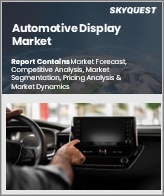
자동차용 디스플레이 세계 시장 규모는 2023년 120억 달러, 2024년 129억 2,000만 달러에서 2032년에는 233억 9,000만 달러로 성장하고, 예측 기간(2025-2032년) CAGR은 7.7%를 보일 것으로 예측됩니다.
AR 기반 헤드업 디스플레이(HUD) 시장은 실시간 내비게이션 기능, 속도 모니터링, 앞 유리에 직접 내장된 경고 시스템 등의 발전으로 크게 성장하고 있으며, AI 기술의 접목은 이러한 HUD를 강화하여 차선 이탈 경고, 보행자 감지, 자율주행 및 첨단운전자보조시스템(ADAS)의 발전에 기여하고 있습니다. 보행자 감지 등의 기능을 가능하게 하여 자율주행과 첨단운전자보조시스템(ADAS)의 진화에 기여하고 있습니다. 이러한 추세는 몰입감 있고 직관적인 운전 경험에 대한 수요 증가를 촉진하고 안전과 상황 인식을 향상시킵니다. 또한, 제조업체들은 대형, 고해상도 OLED 및 QLED 디스플레이를 선호하고 있으며, 곡면 및 투명 스크린과 같은 혁신적인 디자인에 유연하게 대응할 수 있는 OLED 및 QLED 디스플레이를 선호하고 있습니다. 이러한 변화는 미적 감각을 향상시킬 뿐만 아니라 차량 내부의 기능성을 최적화하여 첨단 디스플레이를 현대 자동차 사용자 경험에 필수적인 구성 요소로 자리 매김하고 있습니다.
Global Automotive Display Market size was valued at USD 12.0 billion in 2023 and is poised to grow from USD 12.92 billion in 2024 to USD 23.39 billion by 2032, growing at a CAGR of 7.7% during the forecast period (2025-2032).
The market for AR-based heads-up displays (HUDs) is experiencing significant growth, driven by advancements in real-time navigation capabilities, speed monitoring, and alert systems integrated directly onto windshields. The incorporation of AI technologies enhances these HUDs, enabling features such as lane departure warnings and pedestrian detection, contributing to the evolution of autonomous driving and advanced driver-assistance systems (ADAS). This trend fosters heightened demand for immersive and intuitive driving experiences, enhancing safety and situational awareness. Additionally, manufacturers are increasingly prioritizing larger, high-resolution OLED and QLED displays, which offer flexibility for innovative designs, including curved and transparent screens. This shift not only elevates aesthetics but also optimizes cabin functionality, positioning advanced displays as essential components of modern automotive user experiences.
Top-down and bottom-up approaches were used to estimate and validate the size of the Global Automotive Display market and to estimate the size of various other dependent submarkets. The research methodology used to estimate the market size includes the following details: The key players in the market were identified through secondary research, and their market shares in the respective regions were determined through primary and secondary research. This entire procedure includes the study of the annual and financial reports of the top market players and extensive interviews for key insights from industry leaders such as CEOs, VPs, directors, and marketing executives. All percentage shares split, and breakdowns were determined using secondary sources and verified through Primary sources. All possible parameters that affect the markets covered in this research study have been accounted for, viewed in extensive detail, verified through primary research, and analyzed to get the final quantitative and qualitative data.
Global Automotive Display Market Segments Analysis
Global Automotive Display Market is segmented by Product, Screen Size, Display Technology and region. Based on Product, the market is segmented into Center stack display, Instrument cluster display, Head-up display and Rear-seat entertainment display. Based on Screen Size, the market is segmented into Less than 5", 5" to 10" and Above 10". Based on Display Technology, the market is segmented into TFT-LCD and OLED. Based on region, the market is segmented into North America, Europe, Asia Pacific, Latin America and Middle East & Africa.
Driver of the Global Automotive Display Market
The automotive display market is expected to experience significant growth in the upcoming years due to the increasing production of vehicles. This process entails the large-scale manufacturing of uniform car models, which fosters widespread availability. Automotive display systems are essential for conveying vital information about the vehicle, thereby improving communication with drivers. As there is a heightened focus on vehicle safety and driver assistance technologies, the demand for innovative automotive display solutions is continuously on the rise, further propelling market expansion. Overall, the interplay of these factors is set to drive the growth of the global automotive display market.
Restraints in the Global Automotive Display Market
The Global Automotive Display market faces certain constraints due to the complexities involved in developing advanced display technologies such as OLED, microLED, and AR-HUDs. These innovations necessitate elaborate manufacturing processes and high-quality materials, leading to elevated production costs. This financial burden poses a significant obstacle for budget and mid-range vehicle segments that may struggle to implement such sophisticated displays. Moreover, the integration of these advanced systems into existing vehicle architectures requires substantial synchronization of both software and hardware, further escalating development times and expenses. As a result, these factors hinder the widespread adoption of advanced automotive display technologies in the market.
Market Trends of the Global Automotive Display Market
The Global Automotive Display market is experiencing a significant transformation, driven primarily by advancements in Artificial Intelligence (AI). As manufacturers increasingly integrate AI technologies, the market is witnessing enhanced user experience through intuitive interfaces and smarter interactions between drivers and vehicles. AI-powered adaptive displays are revolutionizing how information is presented, tailoring content in real-time according to driver behavior, road conditions, and individual preferences, ultimately fostering a safer driving experience. Furthermore, innovations like Augmented Reality (AR) Head-Up Displays (HUDs) are gaining traction, offering real-time navigation and hazard detection, thereby improving situational awareness and propelling the industry toward a more connected future.